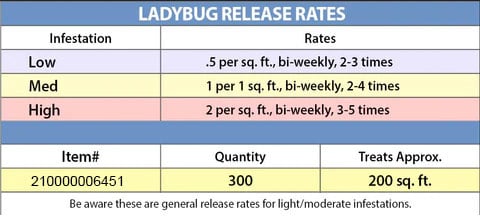Target Pests: Aphids, also moth eggs, mites, scales, thrips, leafhoppers, mealybugs and other slow-moving insects.
Ladybugs are general predators that feed on a variety of slow-moving insects, but they are best known for feeding on aphids. During the adult and larval stages it is a predator. Adults are shiny, hemispherical beetles, often reddish-orange or yellow, with black markings. Larvae are black, with conspicuous legs and orange spots on their backs. They move from plant to plant on leaves. Larvae pupate on the upper leaf surfaces, plant stems and twigs. Eggs are yellowish-orange ovals, laid on end in clusters of 10 to 50.
Convergent ladybird beetles (Hippodamia convergens) are shipped as adults in containers and cloth bags. Storing the beetles can be done at a temperature of 40°F to 60°F for 1 – 3 weeks. Ideally ladybugs should be released in the evening or very early morning when it is cool or overcast so they move more slowly. To improve performance, mist foliage beforehand. Ladybug beetles can begin reproducing immediately with ample food and moisture. Several generations may occur during one season.
